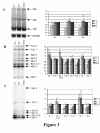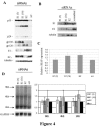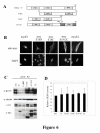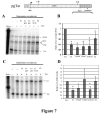hnRNP E1 and E2 have distinct roles in modulating HIV-1 gene expression
- PMID: 17451601
- PMCID: PMC1863430
- DOI: 10.1186/1742-4690-4-28
hnRNP E1 and E2 have distinct roles in modulating HIV-1 gene expression
Abstract
Pre-mRNA processing, including 5' end capping, splicing, and 3' end cleavage/polyadenylation, are events coordinated by transcription that can influence the subsequent export and translation of mRNAs. Coordination of RNA processing is crucial in retroviruses such as HIV-1, where inefficient splicing and the export of intron-containing RNAs are required for expression of the full complement of viral proteins. RNA processing can be affected by both viral and cellular proteins, and in this study we demonstrate that a member of the hnRNP E family of proteins can modulate HIV-1 RNA metabolism and expression. We show that hnRNP E1/E2 are able to interact with the ESS3a element of the bipartite ESS in tat/rev exon 3 of HIV-1 and that modulation of hnRNP E1 expression alters HIV-1 structural protein synthesis. Overexpression of hnRNP E1 leads to a reduction in Rev, achieved in part through a decrease in rev mRNA levels. However, the reduction in Rev levels cannot fully account for the effect of hnRNP E1, suggesting that hmRNP E1 might also act to suppress viral RNA translation. Deletion mutagenesis determined that the C-terminal end of hnRNP E1 was required for the reduction in Rev expression and that replacing this portion of hnRNP E1 with that of hnRNP E2, despite the high degree of conservation, could not rescue the loss of function.
Figures








Similar articles
-
Synergistic stimulation of HIV-1 rev-dependent export of unspliced mRNA to the cytoplasm by hnRNP A1.J Mol Biol. 1999 Feb 5;285(5):1951-64. doi: 10.1006/jmbi.1998.2473. J Mol Biol. 1999. PMID: 9925777
-
Sam68, RNA helicase A and Tap cooperate in the post-transcriptional regulation of human immunodeficiency virus and type D retroviral mRNA.Oncogene. 2000 Jul 27;19(32):3570-5. doi: 10.1038/sj.onc.1203676. Oncogene. 2000. PMID: 10951562
-
A Janus splicing regulatory element modulates HIV-1 tat and rev mRNA production by coordination of hnRNP A1 cooperative binding.J Mol Biol. 2002 Nov 1;323(4):629-52. doi: 10.1016/s0022-2836(02)00967-1. J Mol Biol. 2002. PMID: 12419255
-
RNA-sequence-mediated gene regulation in HIV-1.Infect Agents Dis. 1994 Apr-Jun;3(2-3):68-76. Infect Agents Dis. 1994. PMID: 7812657 Review.
-
The HIV-1 Rev protein.Annu Rev Microbiol. 1998;52:491-532. doi: 10.1146/annurev.micro.52.1.491. Annu Rev Microbiol. 1998. PMID: 9891806 Review.
Cited by
-
Transcriptome protection by the expanded family of hnRNPs.RNA Biol. 2019 Feb;16(2):155-159. doi: 10.1080/15476286.2018.1564617. Epub 2019 Jan 6. RNA Biol. 2019. PMID: 30596342 Free PMC article. Review.
-
Poly(C)-binding protein 1, a novel N(pro)-interacting protein involved in classical swine fever virus growth.J Virol. 2013 Feb;87(4):2072-80. doi: 10.1128/JVI.02807-12. Epub 2012 Dec 5. J Virol. 2013. PMID: 23221550 Free PMC article.
-
Poly(rC)-Binding Protein 2 Does Not Directly Participate in HCV Translation or Replication, but Rather Modulates Genome Packaging.Viruses. 2024 Jul 30;16(8):1220. doi: 10.3390/v16081220. Viruses. 2024. PMID: 39205194 Free PMC article.
-
Identification of a heterogeneous nuclear ribonucleoprotein-recognition region in the HIV Rev protein.J Biol Chem. 2009 Nov 27;284(48):33384-91. doi: 10.1074/jbc.M109.021659. Epub 2009 Oct 5. J Biol Chem. 2009. PMID: 19808671 Free PMC article.
-
Scaffold attachment factor B suppresses HIV-1 infection of CD4+ T cells by preventing binding of RNA polymerase II to HIV-1's long terminal repeat.J Biol Chem. 2018 Aug 3;293(31):12177-12185. doi: 10.1074/jbc.RA118.002018. Epub 2018 Jun 10. J Biol Chem. 2018. PMID: 29887524 Free PMC article.
References
-
- Dirks RW, Hattinger CM, Molenaar C, Snaar SP. Synthesis, processing, and transport of RNA within the three-dimensional context of the cell nucleus. Critical Reviews in Eukaryotic Gene Expression. 1999;9:191–201. - PubMed
Publication types
MeSH terms
Substances
LinkOut - more resources
Full Text Sources
Medical

